Last updated on September 6th, 2023 at 04:10 pm

Welcome back to our two-part deep dive on the art and science of dental practice scheduling. If you’re aiming to maximize efficiency and patient satisfaction in your practice, you’ve come to the right place.
Recap of Part 1:
Before we explore the intricacies of this post, let’s quickly recap what we covered in the first part. Instead of merely listing out a few scheduling tips, our focus was on understanding the core elements that make up a scheduling system that not only works but thrives.
- The essentials your scheduling system must encompass.
- Setting achievable monthly and daily goals.
- Classifying procedures in relation to your scheduling needs.
- The advantages of transitioning to a 10-minute appointment book from a 15-minute one.
For those who may have missed the previous blog post, we recommend giving it a read to ensure you’re fully up-to-speed.
Where We’re Headed in Part 2
In this segment, we’re concluding our discussion by shedding light on several pivotal areas:
- The Role of Your Dental Assistant: Understand how properly utilizing dental assistants can streamline operations and ensure efficiency without compromising patient care.
- Structuring Your Schedule with Precision: Stagger your appointments efficiently between multiple chairs so there is no wasted motion for the doctor.
- Staying fluid: We’ll guide you through the intricacies of embedding emergency appointments without disrupting your day, while maintaining a balance between planned and unplanned events.
- Making it All Work: The end goal is a harmonious system where all elements work in unison. We’ll walk you through the steps to integrate all these tools and techniques for a seamless scheduling experience.
Maximizing Efficiency with Schedule Management and the Role of Dental Assistants
One of the most important factors for having an efficient schedule is utilizing your dental assistants fully.
Utilizing Your Dental Assistants to the Fullest
Every state governs the tasks that a dental assistant can legally undertake through its Dental Practice Act. Familiarizing yourself with this is paramount. If unaware of the specifics, it’s imperative to acquaint yourself with the Dental Practice Act of your jurisdiction to gain clarity on the scope and limits of an assistant’s functions.
However, legal permissions aside, there might be tasks your assistant is licensed to perform but lacks the skills for. Here’s where training steps in. An adept assistant not only streamlines procedures but also aids in amplifying your practice’s efficiency. After all, the essence of having a dental assistant is to offload tasks that they can competently manage, ensuring your practice runs seamlessly.
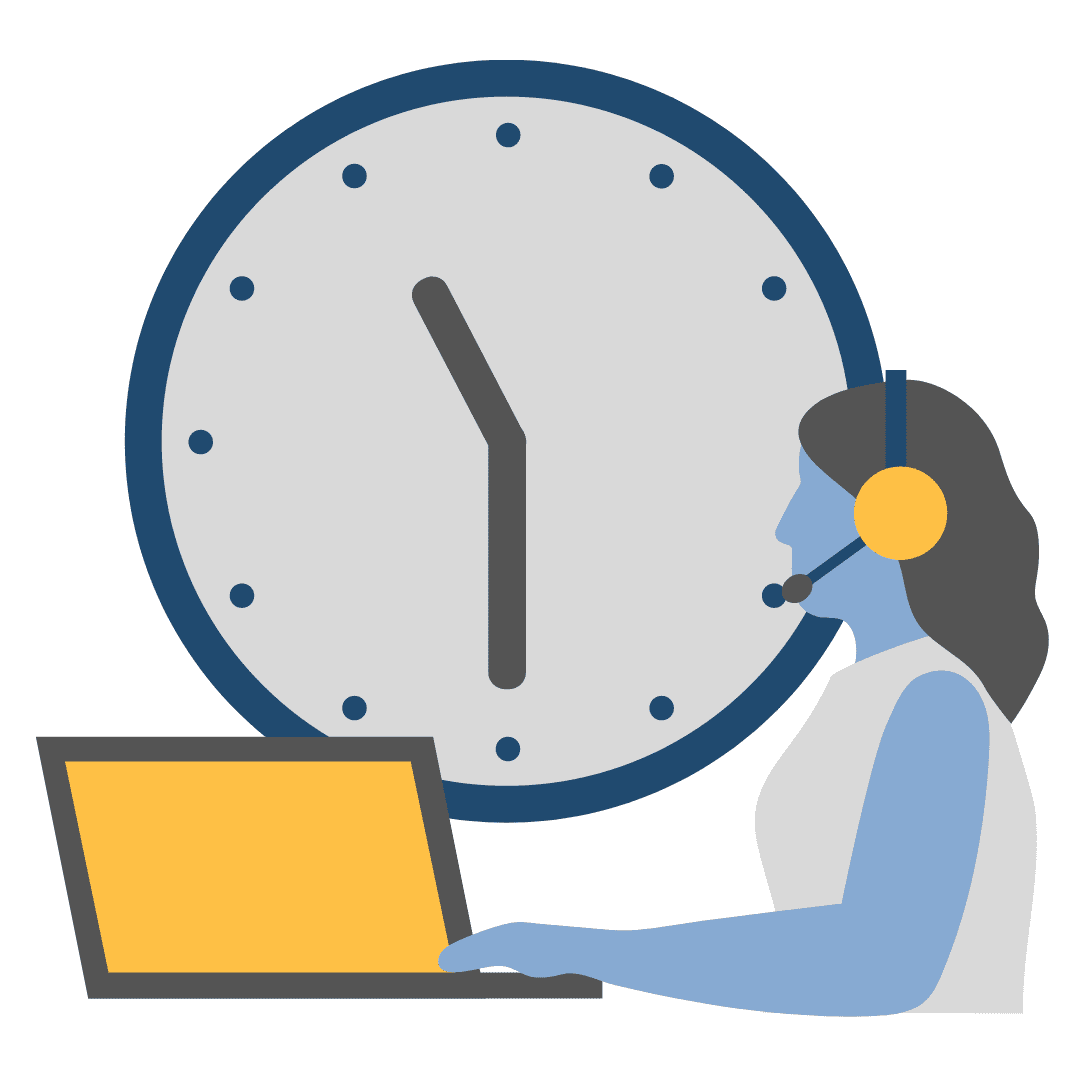 If your assistant can be doing something, they should be doing it. I know that as a doctor, there are certain things you either a) are capable of doing better than an assistant could, or b) you simply enjoy doing yourself. However, there is so much to be gained production-wise by having your EFDAs maximizing their skillsets fully. Ensure your assistants are competent at all these functions to a level that is satisfactory to both you and your patients, and then let them shine.
If your assistant can be doing something, they should be doing it. I know that as a doctor, there are certain things you either a) are capable of doing better than an assistant could, or b) you simply enjoy doing yourself. However, there is so much to be gained production-wise by having your EFDAs maximizing their skillsets fully. Ensure your assistants are competent at all these functions to a level that is satisfactory to both you and your patients, and then let them shine.
Overlapping Appointments for Maximum Efficiency
In order to make this work successfully, these four conditions must be met:
- Dedicated Dental Assistant for Each Room: While occasional role interchangeability is acceptable, assigning a dedicated assistant to each treatment room guarantees better management. This ensures that each room remains stocked, sanitized, and ready for the next procedure.
- Prioritize Primary Procedures: Your appointment ledger should earmark substantial time daily for primary procedures—these are high-value treatments, either due to their complexity or their cumulative worth.
- Logical Scheduling: Ensure that scheduling is rooted in reality. Overbooking—like scheduling a dentist for simultaneous procedures in different rooms—is a recipe for chaos. It’s imperative to recognize the physical constraints of being in only one place at a time.
- Distinguish Between Doctor and Assistant Time: Each procedure’s duration should bifurcate time into doctor involvement and assistant involvement. For instance, if a procedure like a crown installation takes 70 minutes, allocate time segments judiciously between the dentist and the assistant.
Accurately Delineating Doctor vs. Assistant Time
The goal is economy of motion for the doctor. This means that the doctor doesn’t do anything they don’t need to be doing and doesn’t waste any time. Therefore, you need to precisely separate out the assistant time vs. Doctor time for each procedure.
Understanding Doctor Time vs. Assistant Time
- Doctor Time: This is when the dentist is present in a treatment room, and almost always, it involves the dentist collaborating with a dental assistant. A rare exception might be during a patient exam in a hygiene space. But primarily, if it’s marked as “Doctor Time” on the schedule, it denotes both the dentist and assistant are in action.
- Assistant Time: This indicates moments where the assistant is working solo, sans the doctor’s presence. It’s essential for schedules to distinctively represent these durations, ensuring seamless procedural flow.
Now, how do you capture these timelines in your scheduling software?
Slash and X System
The most widely accepted representation is the slash (for assistants) and X (for doctors) system. Think of them as symbols that indicate roles. While some practices might use other symbols like dots or circles, slashes and Xs remain universal across many software and traditional appointment books.
A Practical Scenario:
Imagine a common dental procedure – a single crown prep that takes 70 minutes.
If you’re using a 10-minute appointment book system, that translates to seven 10-minute blocks or “units”. Here’s how the breakdown might typically look:
- First 10 minutes (Assistant Time): The assistant prepares the patient for the procedure.
- Next 40 minutes (Doctor Time): The dentist is entirely engaged, perhaps in prepping the crown.
- Final 20 minutes (Assistant Time): The assistant is primarily involved, maybe in creating the temp, with the dentist checking in briefly to ensure everything is up to standard.
In symbols, this 70-minute procedure would be represented as: /XXXX// (Slash for the assistant, X for the doctor).
The Importance of Precision and Flexibility
While understanding legal and skill parameters is crucial, so is acknowledging individual variations among doctors. Some might take longer for certain procedures, while others might be quicker. The schedule should ideally reflect this unique rhythm for each dentist.
Moreover, always factor in a buffer. If a procedure typically takes 60 minutes, consider blocking off 70 minutes on the schedule. This ensures a buffer for any unforeseen delays and keeps the practice running smoothly.
Working Out of Two Chairs with Overlapping Appointment Times
This scheduling method enables the doctor to operate efficiently using more than one chair. It permits the doctor to commence a procedure with a new patient while the dental assistant in another room is concluding with a prior patient.
Example Scenario:
- Brian’s Crown Prep:
- Location: Room 1.
- Time: Begins at 8:00 AM.
- Schedule Breakdown: Starting with a slash at the 8:00 AM slot, followed by four X’s, and concluding with another two slashes. This totals a 60-minute appointment, wrapping up by 9:10 AM.
- Sally Johns’ Root Canal:
- Context: Sally Johns is up next, with Brian being discharged at 9:10 AM. The assistant will be with Brian for the last 20 minutes of his appointment.
- Location: Room 2. Remember, there’s an assistant for each room.
- Time: Sally is seated at 8:40 AM, which is 30 minutes before Brian’s departure.
- Procedure Breakdown: The root canal starts with a slash for the first 10 minutes, representing assistant time. The subsequent slots are all X’s, denoting the doctor’s involvement. Sally’s procedure is 40-minutes, and the assistant will close out the appointment.
- Overlap: By the time Brian is discharged, the doctor is 10-20 minutes into Sally’s procedure.
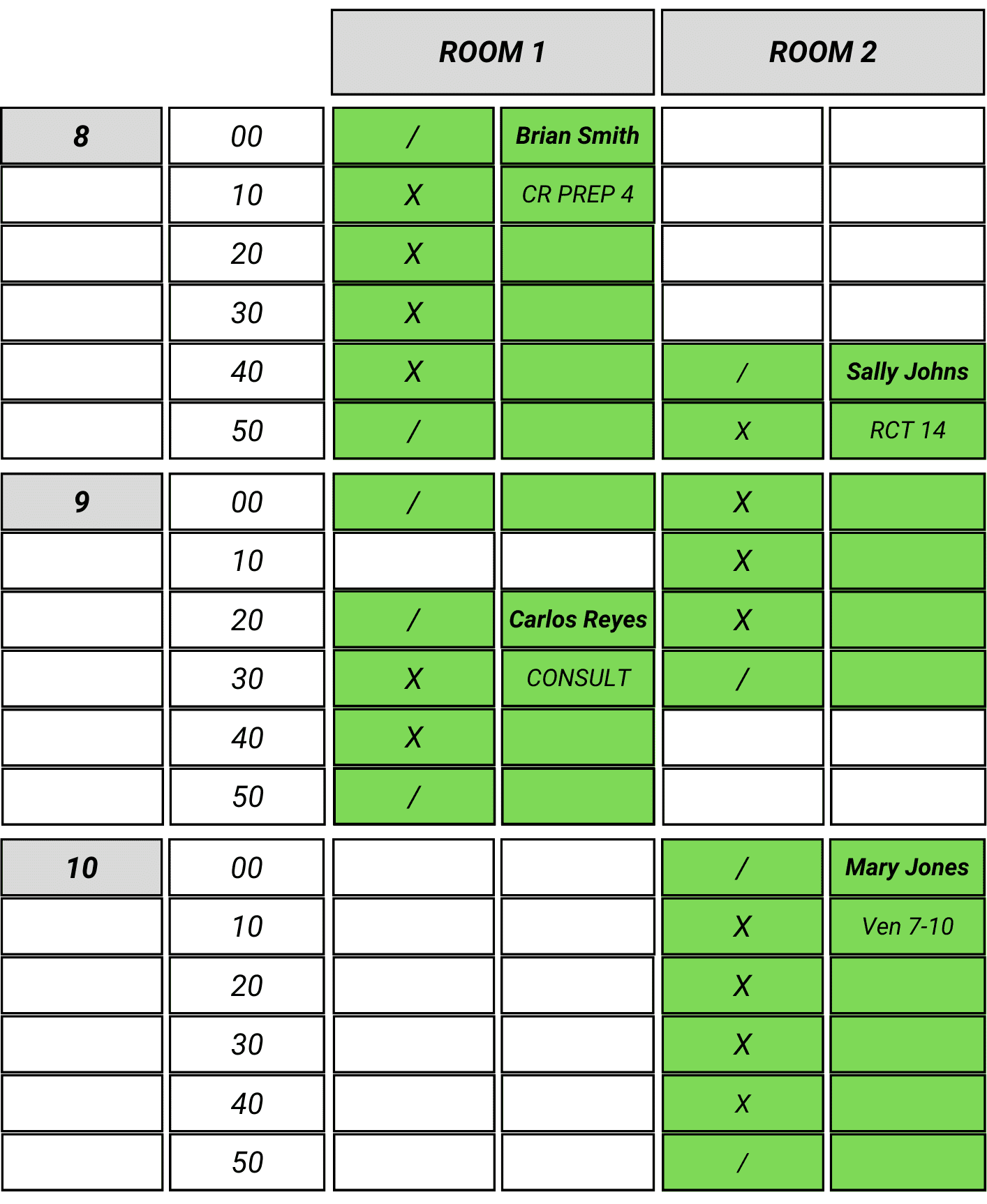
Post Brian, Sally’s root canal procedure finishes by 9:30 AM. At 9:20 AM, Carlos Reyes is ushered into Room 1, succeeding Brian, for a consultation. This effectively maps out a highly productive morning, even before 10:00 AM.
Saving Time
Were we to follow a conventional back-to-back system without overlapping properly and had only one assistant, Brian’s appointment would span from 8:00 AM to 9:10 AM. Sally would then be seated from 9:10 AM to 10:00 AM. However, by overlapping, Sally completes by 9:40 AM, saving 20 minutes. This efficient approach can save hours a day.
It isn’t a one-size-fits-all approach. If a practitioner has just started with a patient count of around 65-75 and is still handling hygiene tasks personally, this may not be beneficial due to limited patient volume. However, with one or two hygienists speeding through procedures, it can be a game-changer. The results? More efficiency, more patients seen, and less hours spent.
Key Aspects & Tips:
- It’s vital to know basic procedures, their duration, and differentiate between doctor and assistant times.
- The appointment software must support the X and slash system (or similar system).
- It’s imperative that the software does not allow two X’s concurrently, which would imply the doctor is attending to two patients simultaneously – a scheduling error.
When executed correctly, this approach to scheduling can be a transformative approach for dental practices, maximizing both time and productivity.
Handling Emergencies
So, you got a call about an emergency, huh? Let’s dive into this.
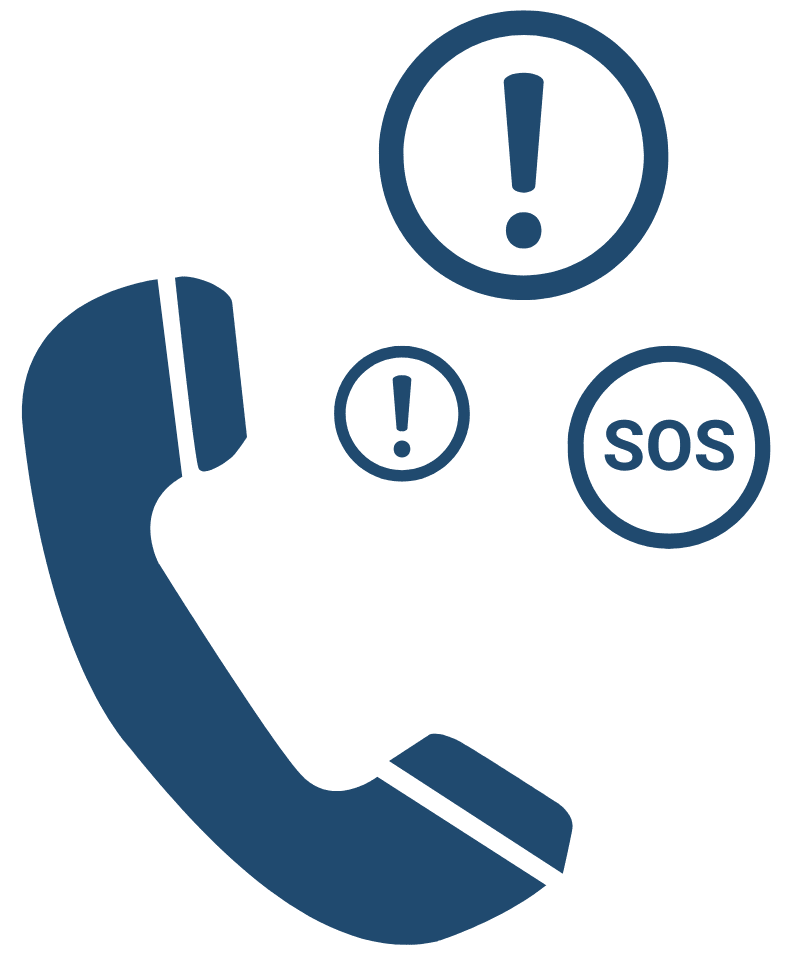
Getting Them in Same Day
I always want to be able to see emergencies same-day—even if it’s just to do a few minutes of palliative care and write a script, and then schedule a comprehensive exam for a later date.
Genuine emergencies are critical and need immediate attention. They can also present opportunities to attract new patients who might be having difficulty finding immediate attention elsewhere. I have seen countless emergencies become great life-long patients, so don’t underestimate the value to accommodating emergencies.
It’s also just good customer service and shows that you care. Emergencies can be nerve-racking for the patient, so getting them in quickly is a kindness.
However, this doesn’t mean you need to bend over backwards or rearrange your schedule to comply with any time the emergency patient requests. With emergencies, waiting is part of the deal and the patient can’t always get their ideal appointment time. Most folks get it. They’re just glad you’re squeezing them in. And hey, if the patient is refusing an 11 AM slot because it’s not convenient for them, then maybe it’s not as much of an emergency as they’re making it sound.
You may want to have a couple pre-set times each day with a little extra buffer so your front office staff know they can use it to squeeze in a quick emergency appointment there.
Scheduling Time to Sell
In the hustle and bustle of the dental world, there’s a key component of scheduling often overlooked: allocating time to sell. It sounds simple, but it’s a game-changer that can spell the difference between a thriving and stagnant practice.
The Importance of Sales Time in Scheduling
We touched on some foundational scheduling aspects last week, and one thing that stood out prominently was the need to schedule time for sales. Most dental practitioners allocate ample time for diagnosis and clinical treatments but forget about sales. And here’s the thing – you simply can’t produce what you don’t sell.
Now, the term ‘sales’ might invoke images of aggressive pitches and pushy tactics, but that’s far from reality in a clinical setting. Sales, in this context, is the art of communication. It’s about conveying the importance of a dental procedure to a patient, ensuring they understand their needs, and making them feel comfortable and informed.
The Two Sides of Sales
- Skill Side of Sales: This pertains to the technique, the ability to persuade, inform, and communicate effectively.
- Organizational Side of Sales: This relates to the structure and time allocation. You could be the best salesperson in the world, but without adequate time to communicate and close a deal, your skills are rendered ineffective.
Here’s a simple analogy: Imagine giving the best salesperson only 5 minutes to close a deal that typically takes half an hour. The result? A missed opportunity.
Example Scenario:
Here’s a typical scenario in dentistry. A patient comes in for a recall exam, and the dentist identifies a treatment plan worth, say, $5,000. But the dentist, pressed for time, skims through the explanation in just 5 minutes. Naturally, the patient, bombarded with information and costs, gets overwhelmed. They retreat, choosing to “think about it” and often end up on the incomplete treatment list, possibly not to return for many months if at all.
Let’s reframe this: A treatment plan of $5,000 might seem straightforward for a dentist. But for someone earning $80,000 annually, that’s a significant chunk of their yearly salary. It’s essentially asking them to decide on spending nearly an entire month’s earnings in just a few minutes! The gravity of such decisions necessitates adequate time for understanding and acceptance.
Related reading: The Wrong Approach to Presenting Treatment
Scheduling Considerations
Building in time for sales doesn’t mean you need hours on end. It’s about smart scheduling. A good rule of thumb? If you can’t finish the sale, don’t start it.
- Allocate a block of time specifically for new patient appointments – ideally about an hour. This ensures there’s enough buffer to communicate the treatment plan thoroughly.
- Schedule consultation appointments dedicated entirely to presenting treatment and making financial arrangements. Consultations aren’t just for full-mouth restorations or “smile makeovers.”
The Best Times of Day for Consultation Appointments
I recommend scheduling consultations first thing in the morning and first thing after lunch.
You might wonder, why would we allocate prime morning slots for consultations, especially considering they technically count as tertiary procedures with no charge? The answer lies in flexibility and the unique nature of consultations.
- As your first patient of the day, you’re undistracted and can give that patient your undivided attention. It’s difficult to communicate effectively to a patient when you’re hopping between rooms.
- While you’re doing a 20-minute consultation to start the day, the assistant can begin seating and prepping the next patient for your first procedure.
- What if one of your big primary procedures for the morning cancels last-minute? Normally, the scheduler would panic, thinking they’d have to pull a patient from tomorrow up to replace it or just lose the production. Well, if your morning consult patient accepts his treatment plan, ask him if he can stick around and do the procedure now. Problem solved!
The same reasoning goes for scheduling consults immediately after lunch.

Steps to Enhance Schedule Efficiency
Now, between Parts 1 & 2 of this blog post, we’ve covered quite a bit. Now let’s lay out all the steps for maximizing efficiency in your schedule:
1. Establish Clear Monthly Goals:
- Goal Setting: Setting monthly goals and translating them into daily objectives is paramount. I went over how to calculate your daily production goals in last week’s post, but here it is again: divide your monthly aim by the number of working days, then deduct hygiene production.
- Keep Treatment Presentations in Mind: In order to make a production goal, your patients need to accept that amount of treatment first. So your team should keep in mind how many treatment presentation opportunities they are putting on the schedule.
2. Daily Production Meetings:
- The Morning Huddle: Discussed previously, the morning huddle can be a gold mine of productivity. Equip your team with the tools they need by providing clarity early in the day.
3. Procedure Duration Analysis:
- Real-time Tracking: Instead of relying on estimates, record the actual time taken for procedures. This helps in refining your scheduling. For instance, if a crown procedure begins at 10:00 AM and concludes at 11:01 AM, that’s a one-hour duration.
- Consistency: Reassess procedure durations regularly to account for any changes in practice or equipment.
- Switch to a 10-Minute Book: While a shift to a 10-minute slot system might be challenging, it offers better flexibility and granularity in scheduling. The key is to transition smoothly, ensuring the change doesn’t disrupt your current schedule. Make sure the entire team is familiar with the new scheduling process to avoid confusion.
4. Utilizing Your Assistants Effectively:
- Skills Evaluation: Before you can efficiently schedule and allocate tasks, it’s imperative to have a confidence in each assistant’s individual skillset. Regularly assess the skills of your assistants. Understand where they excel and areas that require training or development. Knowing what each assistant excels at ensures you delegate tasks more effectively.
- Dedicate an Assistant to Each Operatory: The amount of time you’ll save and extra production you’ll see is worth hiring and paying another assistant.
- Separate “Doctor Time” and “Assistant Time”: After you’ve determined the duration of each procedure, break down each procedure into segments represented by “X”s and slashes. Determine which parts of the procedure are exclusively for the assistant (slash) and which parts require both the doctor (“X”) and assistant. This aids in identifying periods when the assistant is solely responsible, allowing better multitasking and potentially enabling the doctor to attend to other tasks or patients.
- Legal Know-how: Familiarize yourself with state laws to ascertain tasks an assistant can legally undertake. This ensures compliance while maximizing the use of your assistants’ skills.
Related reading: 4 Steps for Finding and Keeping Great Dental Staff
5. Stagger Appointment Times Efficiently:
- Overlapping “Doctor Time” and “Assistant Time”: Use the X and / system to ensure there is no wasted motion for the doctor.
- Forecasting: If your schedule is already booked out a while, consider setting a future date to implement this system, ensuring minimal disruption. If feasible, six weeks could be an ideal timeframe to adjust the schedule and onboard a new dental assistant if needed.
6. Designate Primary Time:
- Morning Optimizations: While mornings are often the preferred primary time due to higher efficiency levels, it’s essential to be flexible based on patient preferences and feedback.
- Balancing Patient Needs: While optimizing your schedule is crucial, ensure it doesn’t come at the cost of patient satisfaction.
7. Prioritize Selling Time:
- Incorporate “Sales Time”: Building dedicated time slots for case presentations can greatly enhance practice revenue. Ensure these slots are not overlooked.
- Selling as a Service: Emphasize the importance of setting aside dedicated time to discuss treatments and services with patients. This is not just about business growth, but about ensuring patients are well-informed and can make the best decisions for their health.
8. Run Scheduling Drills:
- Practice! The age-old saying, “Practice makes perfect,” rings true here. The doctor, office manager, and scheduler should all practice creating mock schedules to identify potential challenges and refine the system.
- Interactive Drills: Engage your team in scheduling simulations to enhance their adaptability and problem-solving skills when unexpected scheduling challenges arise.
Test Your Practice
The last thing I would do to see how these systems might impact your practice is to test them out.
Maybe you’ve heard the term before, “paper trading,” where someone wants to learn how to invest, but they don’t want to use actual money yet because it’s a little too dangerous to do that right.
Well, you can paper trade with your schedule. The benefit? You get to visualize the potential results of a strategy without bearing any real-time consequences.
Here’s how you can apply this to your dental practice:
Schedule Analysis
Start by reviewing a recent week’s schedule – say, from last week or even the week before. The key is to choose a timeframe that reflects your usual patient load and daily operations.
On this ‘paper’ version of your schedule, implement the overlapping X and / strategy. You’re not changing anything in reality, just on this paper version to understand the potential outcomes.
With the new approach, you might discover that certain slots in your morning suddenly become free. This offers an opportunity to fit in more patients without feeling more rushed or hectic, thereby smoothly increasing production.
Witnessing how your schedule would function under this strategy can offer insights into the increased efficiency and productivity it could usher into your practice.
Further Learning and Resources
To truly master each component of dental scheduling, consider:
- Diving into the Art of Scheduling Productively available on DDS success. An updated course is said to be coming soon.
- The Schedule Coordinator training course is another valuable resource. It provides a wealth of data to bolster your scheduling skills.
- For a more hands-on approach, you might contemplate attending the Scheduling for Production seminar at MGE.
Summary
And with that, I’ll say: this is really a case where the more you know, the better. Knowledge is truly empowering. The more insight you gather and the clearer your office policies become, the more efficient and enjoyable your practice will be.
This isn’t just about improving numbers—it’s about fostering a positive environment where both staff and patients thrive. And trust me, when things are running smoothly at work, life outside gets a whole lot more relaxed and pleasurable too.
Until next time, folks. Keep those schedules tight and morale high!
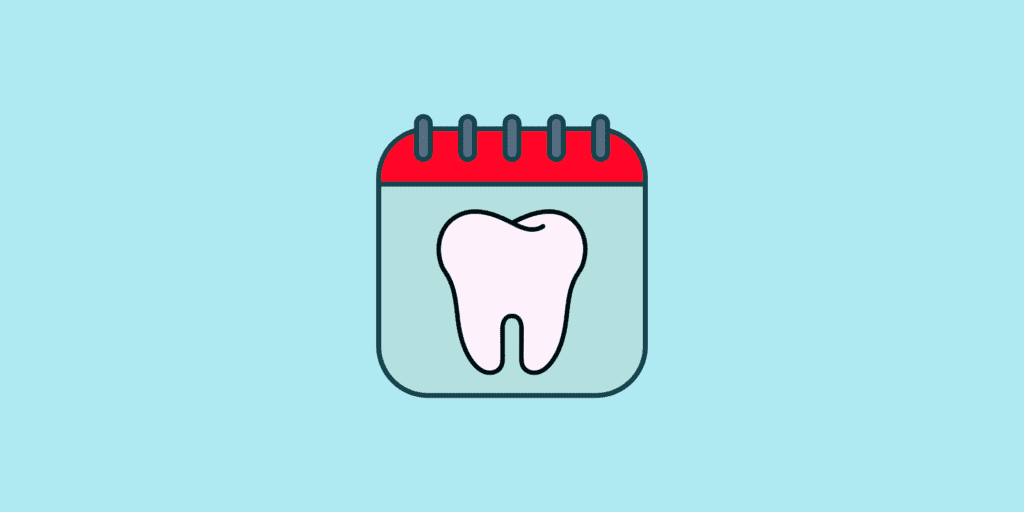

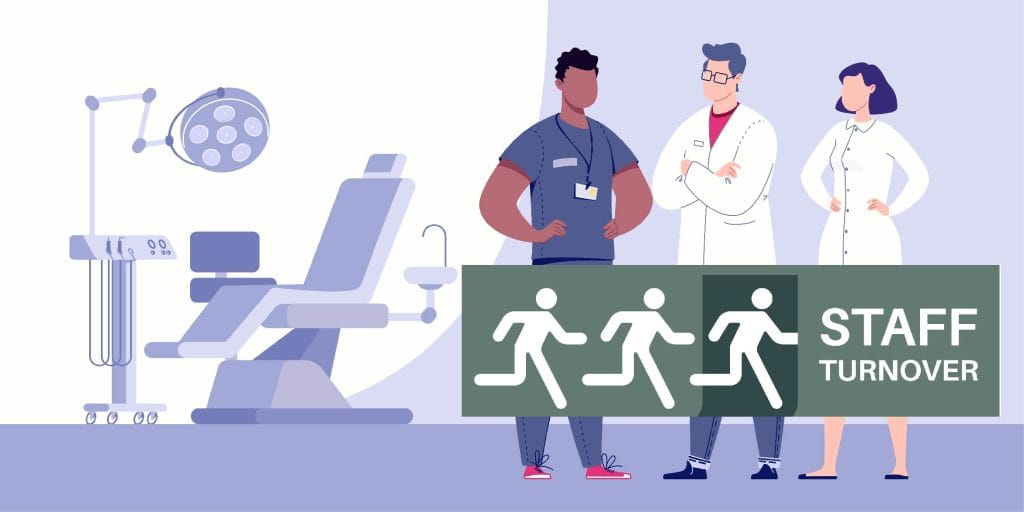
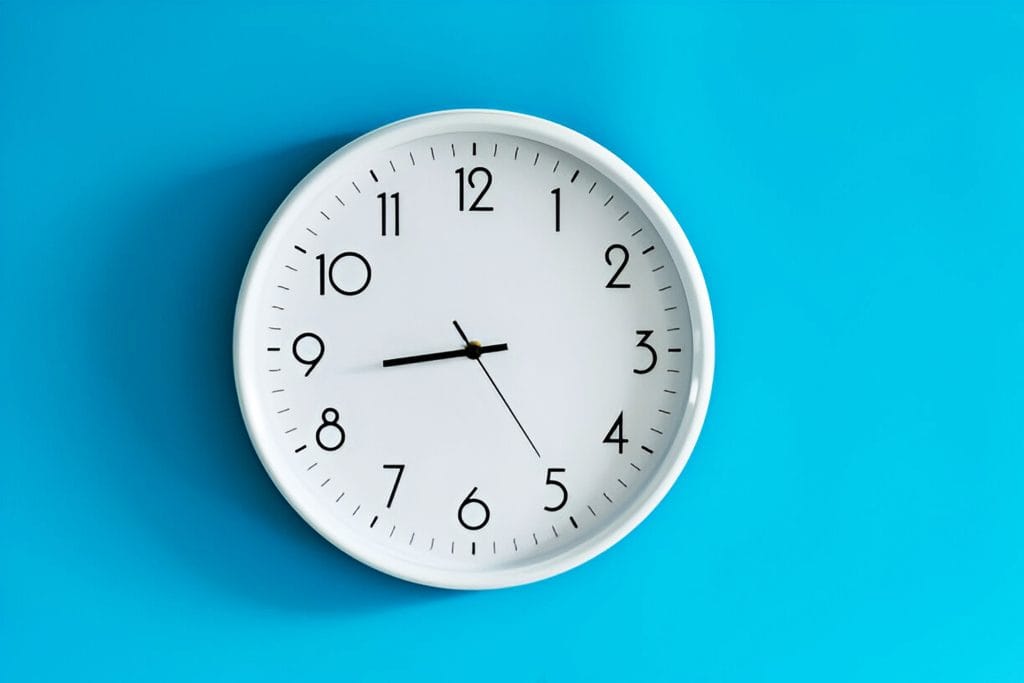
Do you have anyone dedicated to schedule training? I’m interested in additional guidance for our schedule coordinator.
Hi Nicole, Apologize for the late reply – we had some issues with accessing our website comments. You could try our free seminar on the subject: https://mgeonline.com/scheduling-livestream/